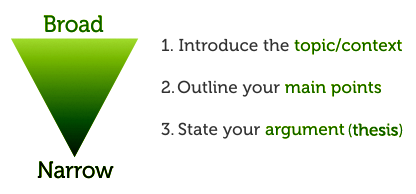Introduction
The introduction tells the reader what the essay is about.
It has three parts:

Notice the clearly defined structure in the sample introduction below.
Sample introduction
Example
Team work plays a big role in the daily and strategic functioning of many current organisations and structures differ depending on their purpose and place within the context of an organisation. Team effectiveness within teams requires evaluation in order to ensure alignment of work with the strategic functioning of an organisation. Team structure tends to reflect its purpose and place within the organisation. Two models of teams reflect their context, goals and purposes. BJB Minerals uses project teams to achieve its goals while ACME Chemicals tends to emply parallel teams to improve output and employee involvement. Each team’s effectiveness can be judged according to its output, social processes and learning. The most critical factors in a strategy for improving effectiveness in each case are a compelling direction, an enabling structure, and access to coaching.
